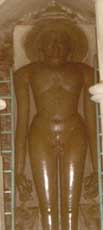

 |  |
 Mahavira (599?-527? B.C.) was a teacher of the religion of Jainism. He lived in India. His followers believed that he was the 24th in a line of great teachers. These teachers were called tirthankaras. Rishabha was the first tirthankara. Mahavira preached non-violence, urging his followers to show kindness to all living creatures, and to become vegetarians so that animals would not be killed for food.
Mahavira (599?-527? B.C.) was a teacher of the religion of Jainism. He lived in India. His followers believed that he was the 24th in a line of great teachers. These teachers were called tirthankaras. Rishabha was the first tirthankara. Mahavira preached non-violence, urging his followers to show kindness to all living creatures, and to become vegetarians so that animals would not be killed for food.
His original name was Vardhamana. But later he was called Mahavira, which means The Great Hero. Mahavira was set to have been born in Kundagrama, Vaishali, in Bihar state. A memorial has been built there, and a center set up for the study of Jainism and nonviolence. His father was a rich kshatriya. He was married to a Princes named Yashoda who bore him a daughter. According to tradition, at the age of 30, Mahavira left his home, wife, and child. He became an ascetic, a person who practices strict self-denial. During the next 12 years, he spent much time meditating, fasting, and undergoing severe self-punishment to gain wisdom. In the 13th year, he attained enlightenment (understanding of ultimate truth) and became Jina or the conqueror. He then became a religious teacher and founded an order of monks and nuns. His followers came to be called Jinas or Jains - those who conquered their desires. He traveled much in the next thirty years and preached in the neighborhoods of Anga, Videha & Magadha. Mahavira spoke the language of the people and enjoyed the patronage of the rulers of his time - rulers of Anga, Videha and Magadha. He set up a well-knit religious organization known as the Sangha. Mahavira died at the age of 72, near Rajgir in Bihar. At the time of his death he had about 14,000 followers. Some followers of Mahavira followed a severe path of renunciation to the extent of discarding clothes. They were called digambaras (the sky clad). Digambaras were orthodox followers of Mahavira. They kept long fasts and led an extreme austere life. Others who used to wear white tunics, considered it a duty to fulfill their obligation to society. They were called svetambaras (the white clad). They kept fasts but did not believe in extreme penance and austerity. next page >> |
Copyright ©2000 indiansaga.info. All rights reserved.
By using this service, you accept that you won't copy or use the data given in this website for any commercial purpose.
The material on indiansaga.info is for informational & educational purpose only.
This site is best viewed at 800 X 600 picture resolution.